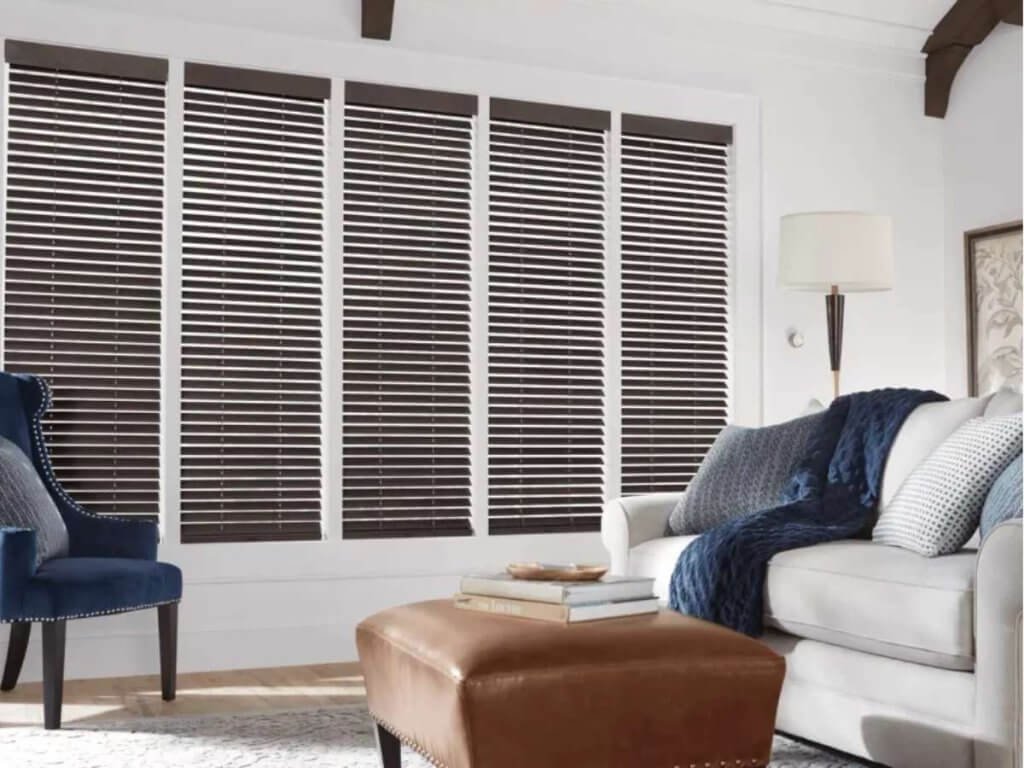When it comes to selecting window treatments, few options strike a balance between timeless appeal and everyday function quite like wood blinds. Maybe you’re tired of flimsy window treatments that warp in the sun or struggling with fabrics that don’t give you the level of privacy you need. Or perhaps you’re simply trying to find something that complements both your cozy reading nook and your modern kitchen. Whatever your reason, the decision to invest in wood blinds comes with several important considerations.
Let’s take a closer look at the wood blinds pros and cons to help you determine whether they’re the right fit for your home and lifestyle.
The Pros of Wood Blinds
1. Natural Beauty and Timeless Style

Wood blinds bring undeniable warmth and character to any space. Made from real wood like basswood, oak, or cherry, they enhance your home decor with rich grains, natural finishes, and a classic aesthetic that can fit both traditional and modern interiors.
Whether you lean toward rustic farmhouse or sleek minimalist design, wood blinds are versatile enough to complement almost any aesthetic.
2. Excellent Light Control and Privacy

With adjustable slats, wood blinds give you full control over how much natural light enters your space. Tilt them open to invite the sun in or close them tightly for total privacy. This level of control is especially helpful in bedrooms, living rooms, and offices where lighting and visibility matter.
3. Superior Insulation
Natural wood is a great insulator. In the winter, it helps keep warm air in; in the summer, it blocks out the sun’s heat. This thermal efficiency can make a noticeable difference in your home’s overall comfort—and may even help reduce energy costs.
4. Durability and Longevity
When properly cared for, wood blinds are built to last. They’re sturdier than many synthetic alternatives and less likely to bend or crack with daily use. Their solid construction makes them ideal for homeowners seeking a long-term investment.
The Cons of Wood Blinds
1. Higher Cost Upfront
One of the most significant drawbacks of wood blinds is their price. Compared to faux wood or vinyl alternatives, they come with a higher initial cost. However, many homeowners find that the durability, beauty, and performance of real wood justify the investment.
2. Susceptible to Moisture and Humidity
Because wood is a natural material, it doesn’t fare well in high-moisture environments like bathrooms, laundry rooms, or kitchens. Over time, exposure to humidity can cause warping, swelling, or cracking. If you need blinds in moisture-prone areas, faux wood may be the better choice.
3. Maintenance Requirements
Wood blinds require regular dusting and occasional polishing to maintain their appearance. They are also more sensitive to harsh cleaning agents, which can damage the finish or strip the wood. If you’re seeking a low-maintenance option, these may not be ideal.
Key Considerations Before Making a Decision
Style vs. Function
If you’re aiming to create a cohesive, stylish interior with natural accents, wood blinds check all the boxes. However, consider how often you’ll adjust them, how much maintenance you’re comfortable with, and where they’ll be installed.
Budget and Longevity
Think of wood blinds as a long-term investment. While the upfront cost is higher, their longevity and aesthetic impact may provide better value over time compared to more disposable options.
Environmental Conditions
Evaluate the climate and moisture levels in the room. For homes in dry environments, wood blinds are a fantastic choice. In more humid areas, pairing them with proper ventilation or selecting alternatives might be wiser.
FAQs About Wood Blinds
1. Can wood blinds be motorized?
Yes, many wood blinds can be motorized for added convenience. Motorized systems allow you to tilt or raise/lower your blinds using a remote control, smartphone, or even voice commands, enhancing both ease of use and child safety.
2. Do wood blinds block out all sunlight?
Wood blinds offer excellent light control but are not considered blackout window treatments. While closing the slats can significantly darken a room, small gaps between slats may still allow some light to filter through. For full blackout capability, consider pairing them with drapery.
3. Can wood blinds be cut to fit odd-shaped or specialty windows?
Wood blinds are best suited for standard rectangular windows. While they can be custom-sized for width and height, they are not typically recommended for arched or angled windows. For specialty shapes, other window treatments like shutters or cellular shades may be more appropriate.
Your Next Step Toward Stylish, Functional Windows
If you’re craving a refined look, dependable privacy, and long-term value, wood blinds may be just what your home needs. They offer a sophisticated touch to your interior design while providing practical benefits like insulation and light control. But they also require a bit of care and might not be ideal for every room—especially ones with high humidity.
So ask yourself: Do you want a window treatment that adds both form and function? Are you okay with a little extra upkeep in exchange for natural beauty and lasting quality?
If the answer is yes, then wood blinds are absolutely worth considering.
Ready to explore wood blinds for your space?
At Incredible Windows, we offer in-home consultations to help you find the perfect fit for your windows, lifestyle, and budget. Let’s work together to create a home that looks as good as it feels. Schedule your in-home consultation today!
